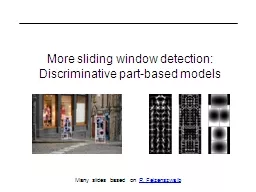

Discriminative partbased models Many slides based on P Felzenszwalb Challenge Generic object detection Pedestrian detection Features Histograms of oriented gradients HOG Partition image into 8x8 pixel blocks and compute histogram of gradient orientations in each block ID: 263070
Download Presentation The PPT/PDF document "More sliding window detection:" is the property of its rightful owner. Permission is granted to download and print the materials on this web site for personal, non-commercial use only, and to display it on your personal computer provided you do not modify the materials and that you retain all copyright notices contained in the materials. By downloading content from our website, you accept the terms of this agreement.
Slide1
More sliding window detection:Discriminative part-based models
Many slides based on
P
.
FelzenszwalbSlide2
Challenge: Generic object detectionSlide3
Pedestrian detection
Features: Histograms of oriented gradients (HOG)
Partition image into 8x8 pixel blocks and compute histogram of gradient orientations in each blockLearn a pedestrian template using a linear support vector machine
At test time, convolve feature map with template
N.
Dalal
and
B.
Triggs
,
Histograms
of Oriented Gradients for Human
Detection
, CVPR
2005
Template
HOG feature map
Detector response mapSlide4
Discriminative part-based models
P.
Felzenszwalb
, R.
Girshick
, D.
McAllester
, D.
Ramanan
,
Object
Detection with Discriminatively Trained Part Based
Models
, PAMI 32(9), 2010
Root filterPart filters
Deformation weightsSlide5
Object hypothesis
Multiscale model: the resolution of part
filters is twice the resolution of the rootSlide6
Scoring an object hypothesis
The score of a hypothesis is the sum of filter scores minus the sum of deformation costs
Filters
Subwindow
features
Deformation weights
DisplacementsSlide7
Scoring an object hypothesis
The score of a hypothesis is the sum of filter scores minus the sum of deformation costs
Recall: pictorial structures
Matching cost
Deformation cost
Filters
Subwindow
features
Deformation weights
DisplacementsSlide8
Scoring an object hypothesis
The score of a hypothesis is the sum of filter scores minus the sum of deformation costs
Concatenation of filter and deformation weights
Concatenation of
subwindow
features and displacements
Filters
Subwindow
features
Deformation weights
DisplacementsSlide9
Detection
Define the score of each root filter location as the score given the best part placements:Slide10
Detection
Define the score of each root filter location as the score given the best part placements:
Efficient computation: generalized distance transforms
For each “default” part location, find the best-scoring displacement
Head filter
Head filter responses
Distance transformSlide11
DetectionSlide12
Matching resultSlide13
Training
Training data consists of images with labeled bounding boxesNeed to learn the filters and deformation parametersSlide14
Training
Our classifier has the form
w
are model parameters, z are latent hypotheses
Latent SVM
training:
Initialize
w
and iterate:
Fix
w
and find the best
z for each training example (detection)
Fix z and solve for w (standard SVM training)
Issue: too many negative examplesDo “data mining” to find “hard” negativesSlide15
Car model
Component 1
Component 2Slide16
Car detectionsSlide17
Person modelSlide18
Person detectionsSlide19
Cat modelSlide20
Cat detectionsSlide21
Bottle modelSlide22
More detectionsSlide23
Quantitative results (PASCAL 2008)
7 systems competed in the 2008 challenge
Out of 20 classes, first place in 7 classes and second place in 8 classes
Bicycles
Person
Bird
Proposed approach
Proposed approach
Proposed approach